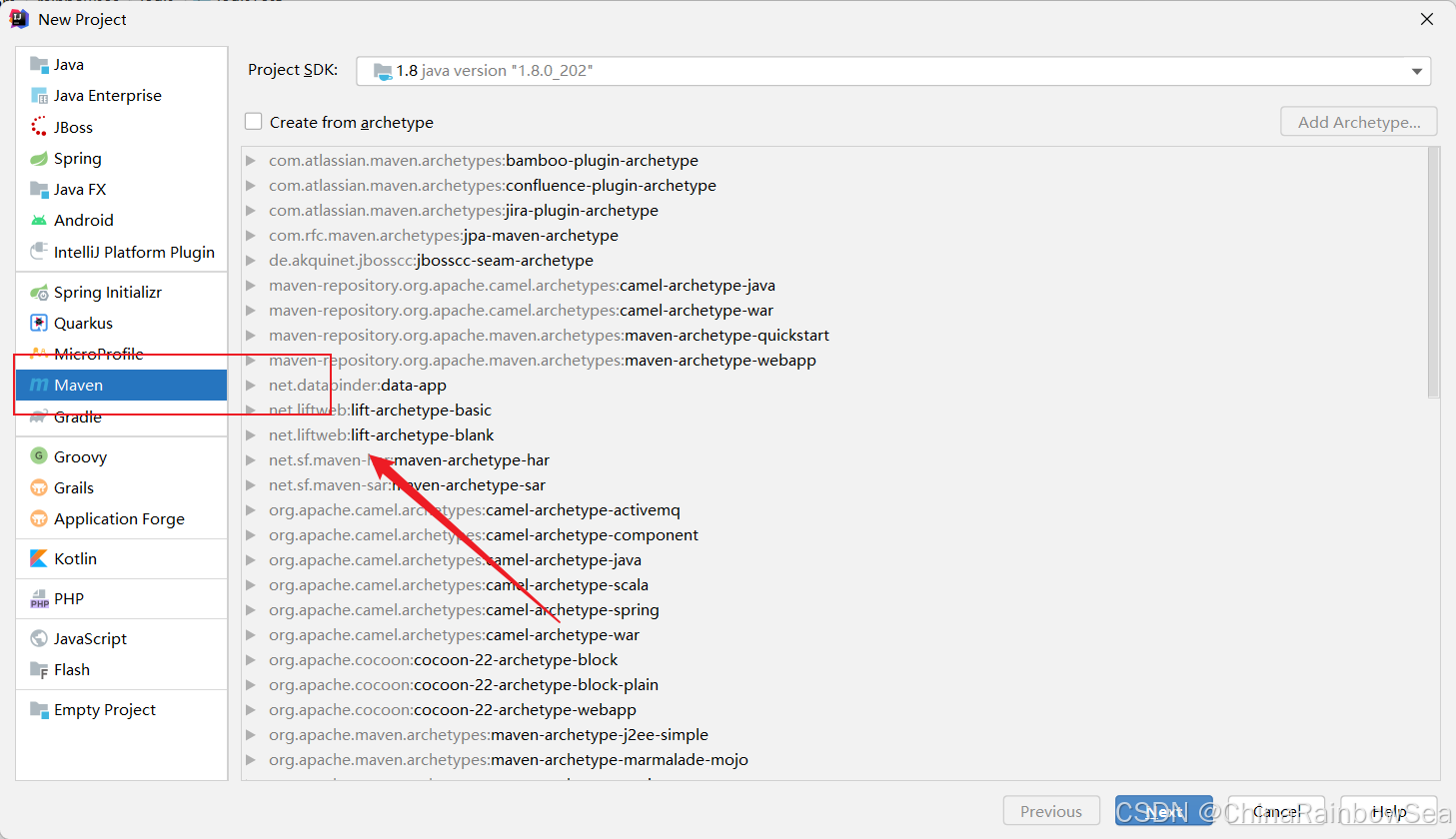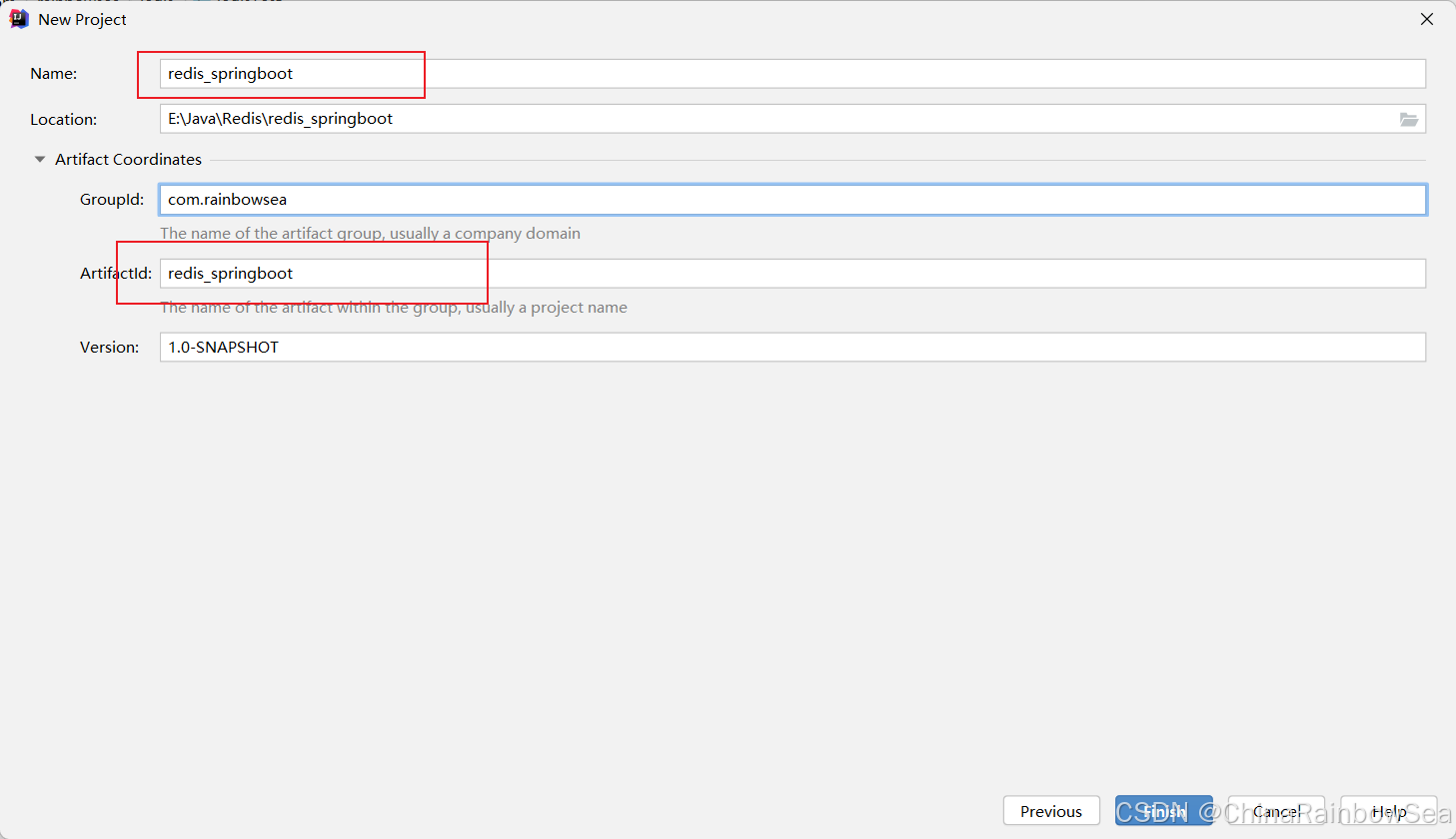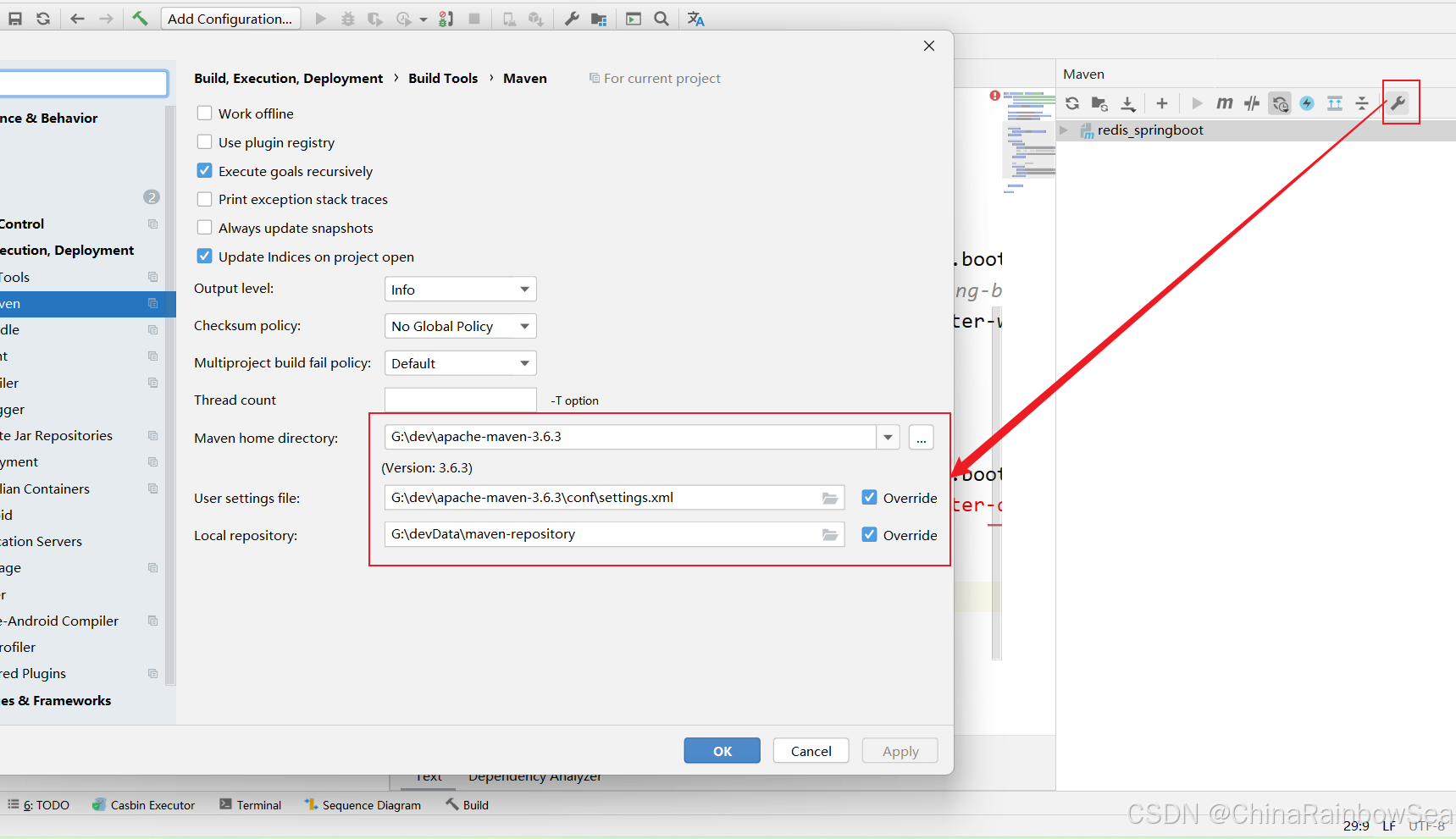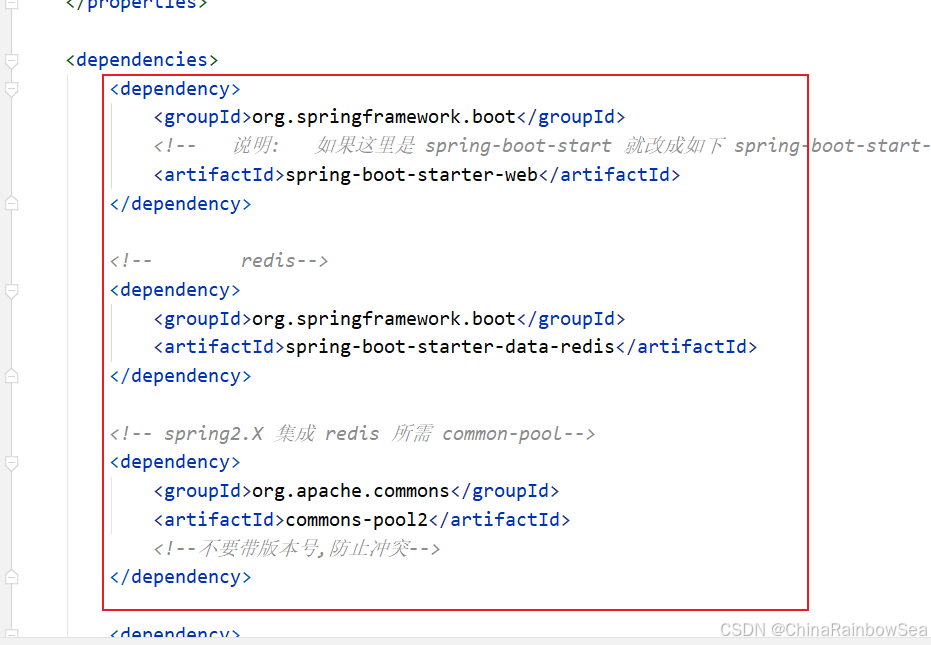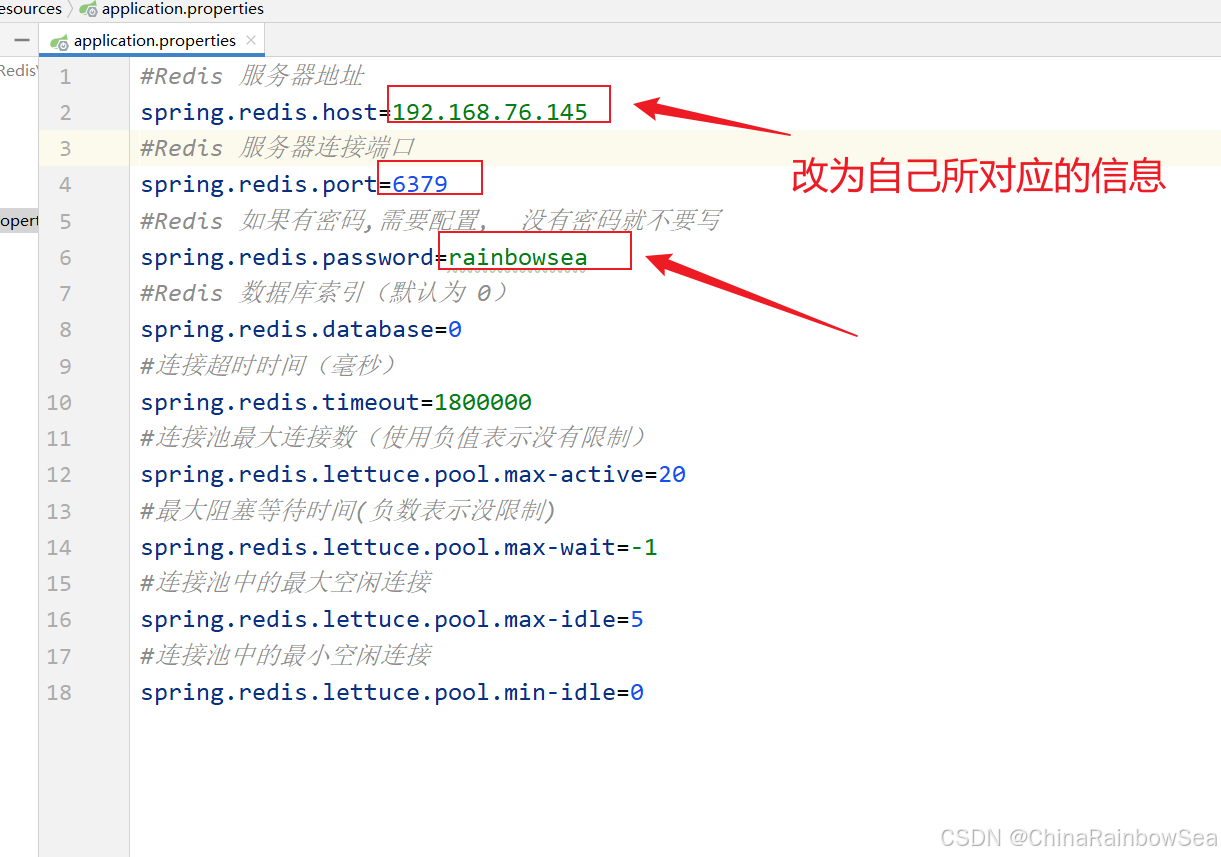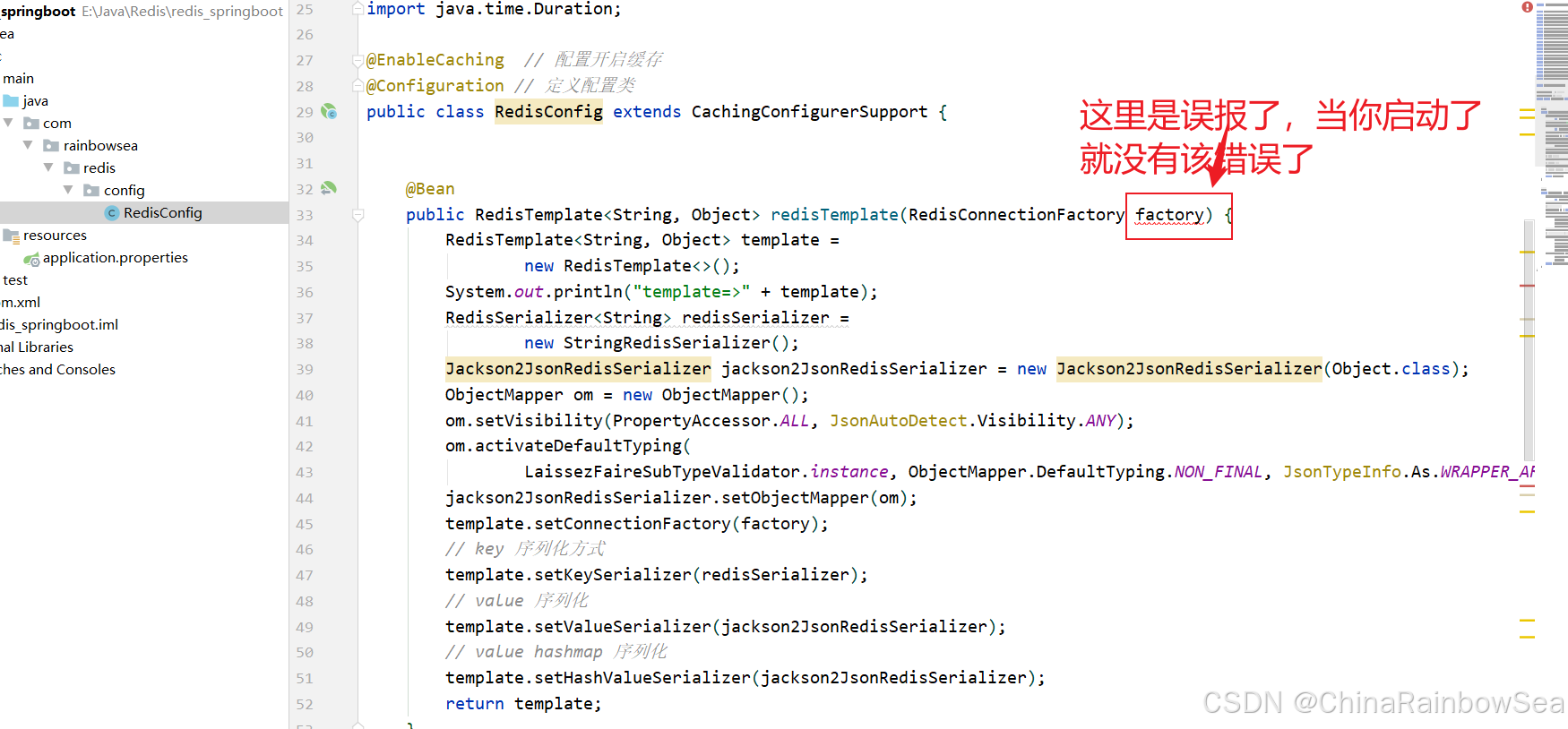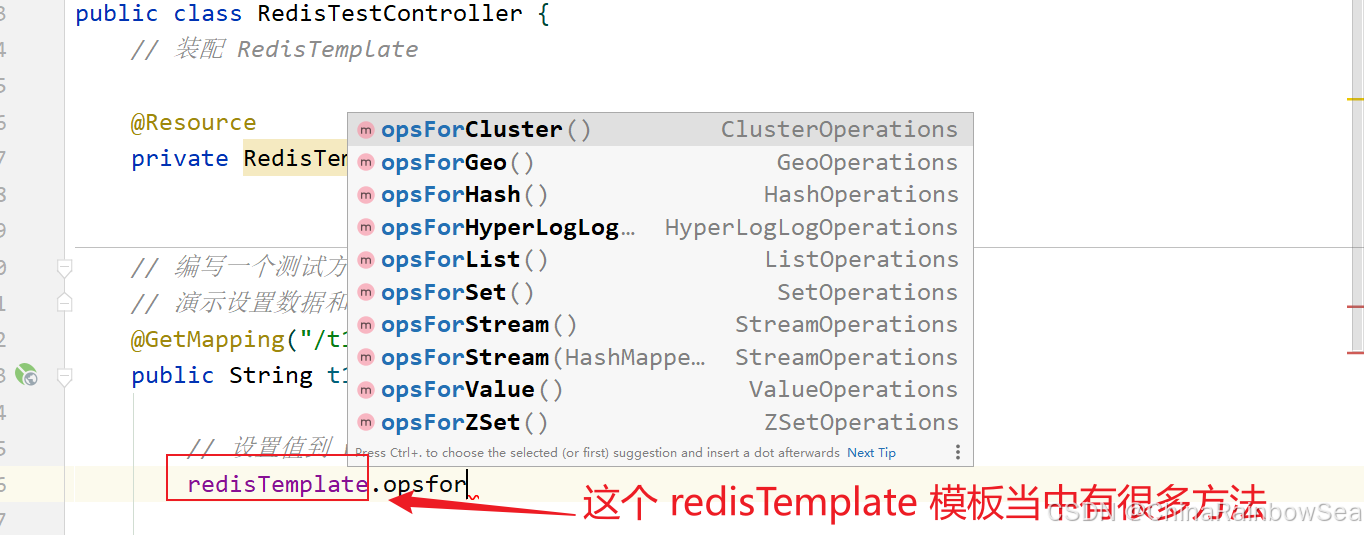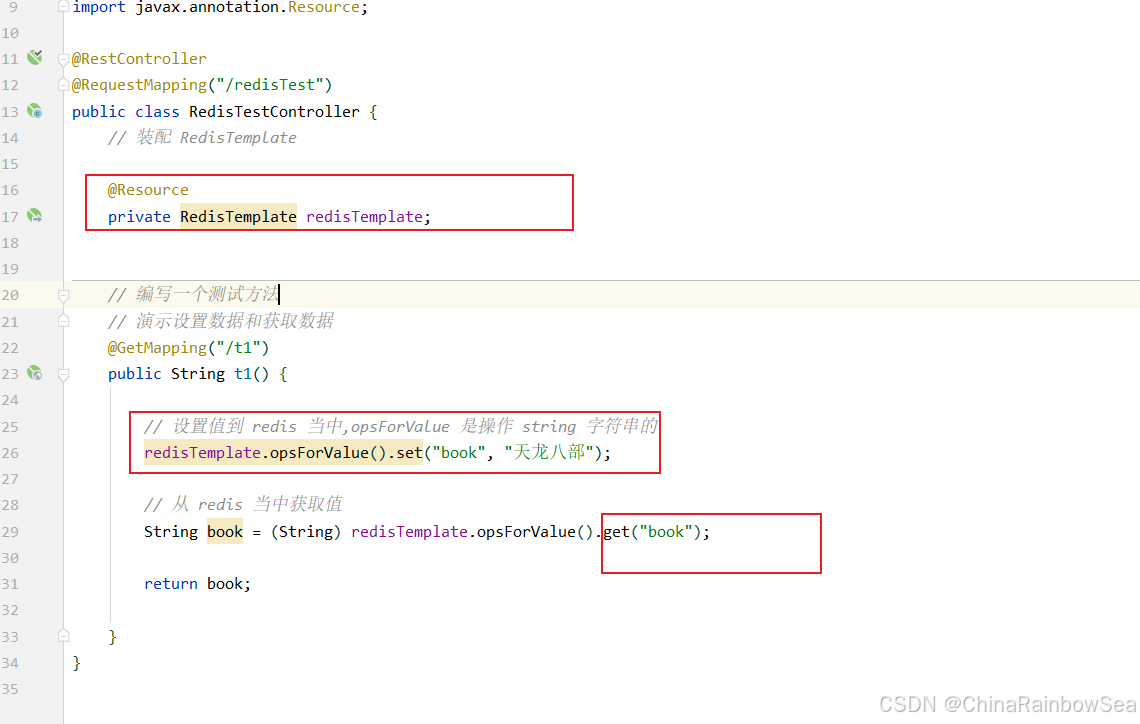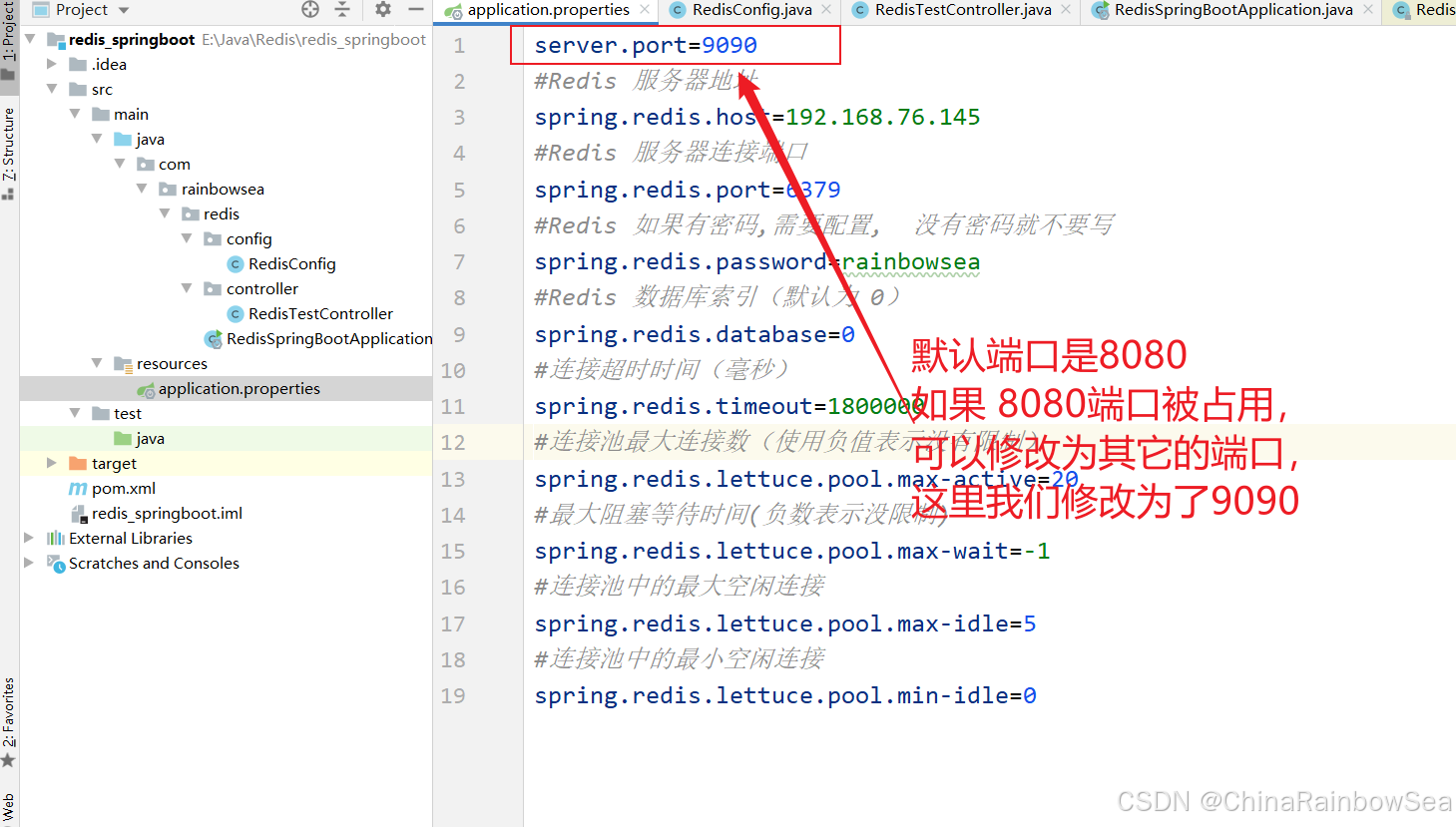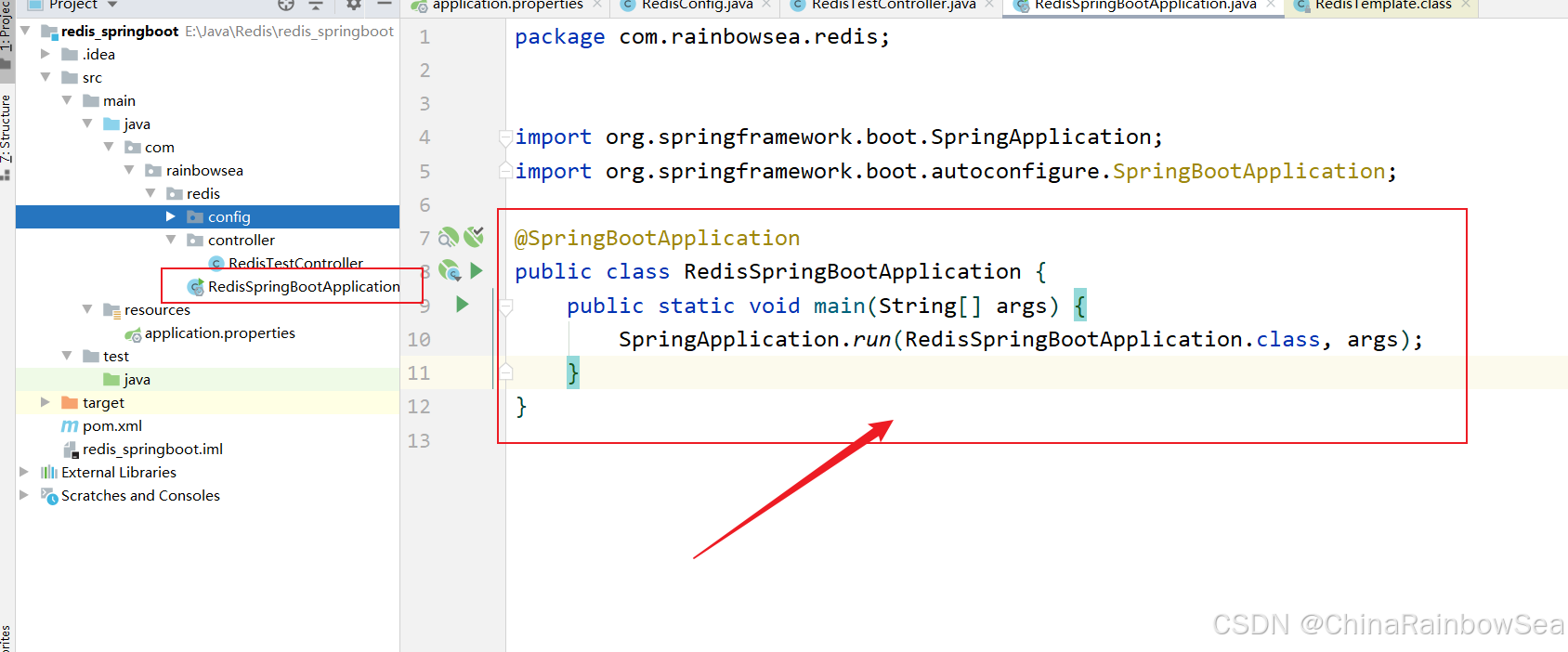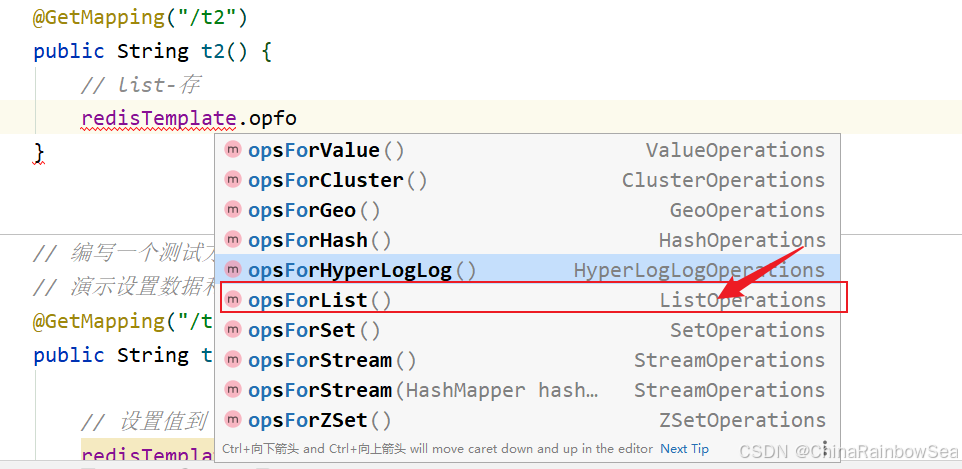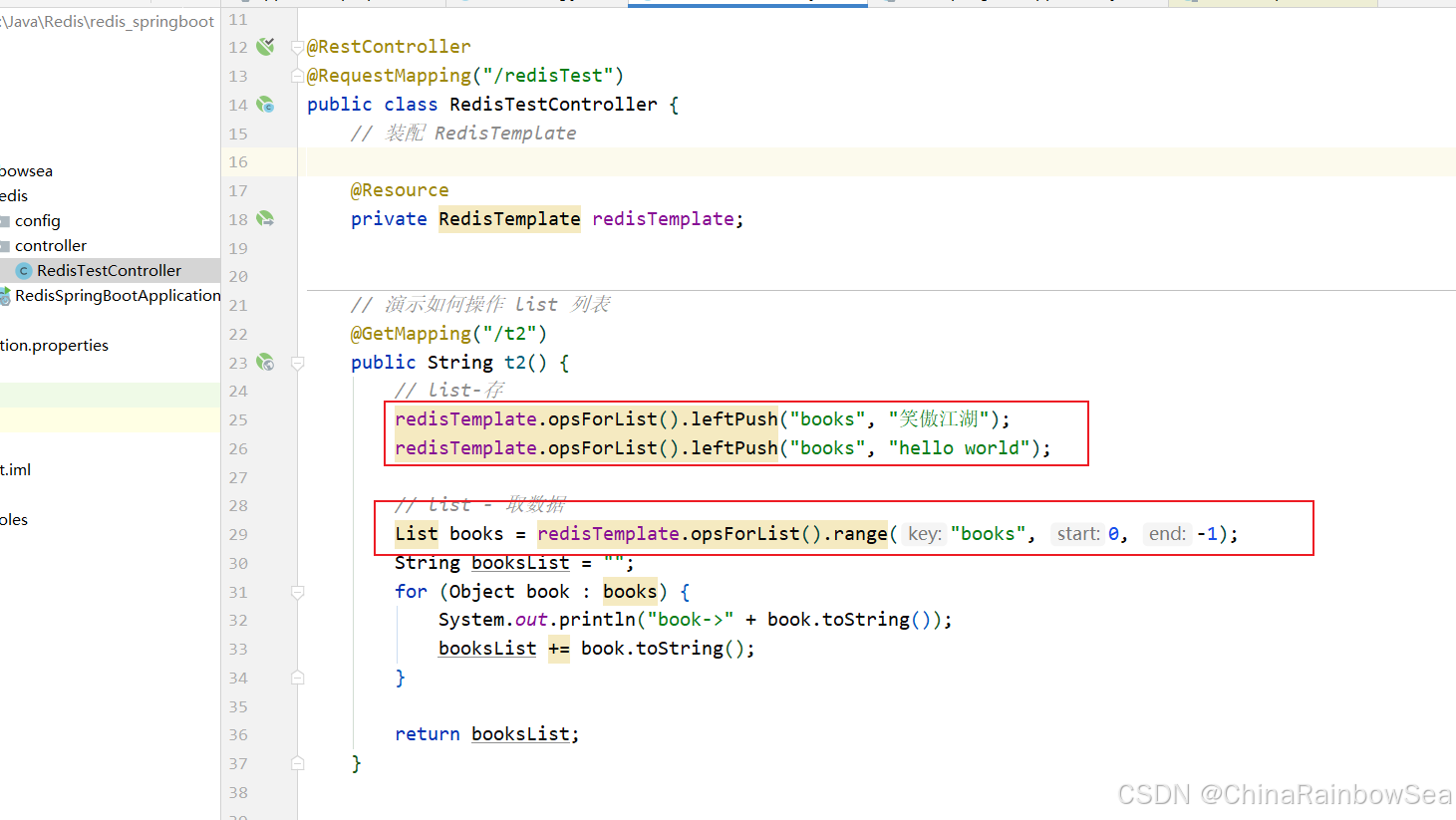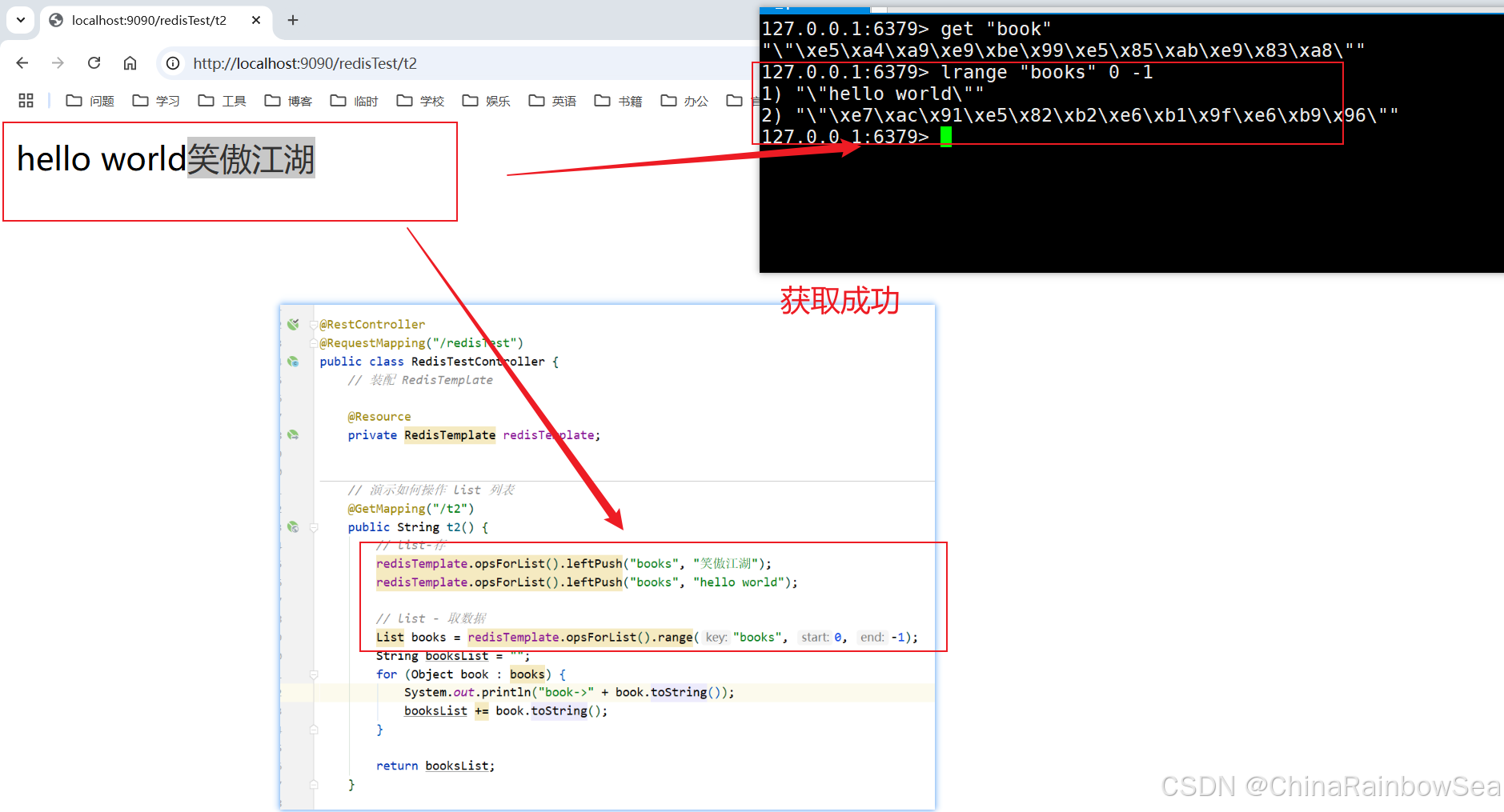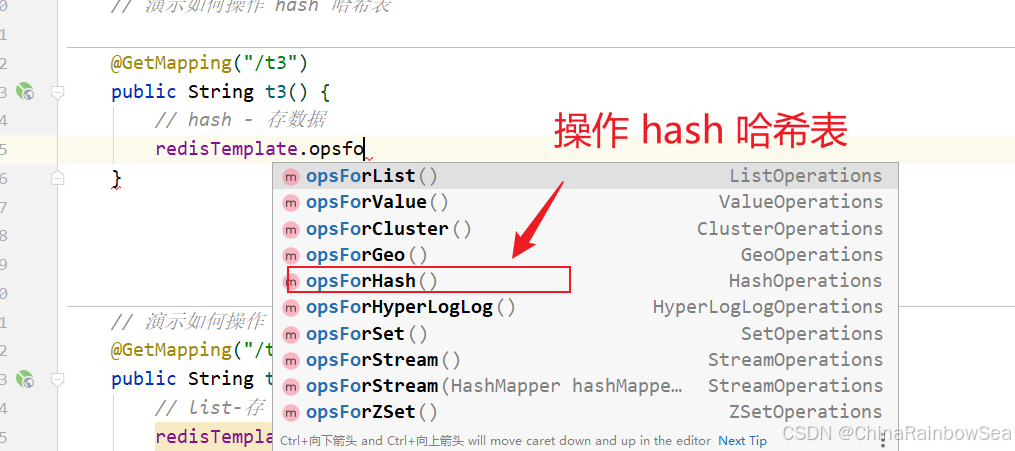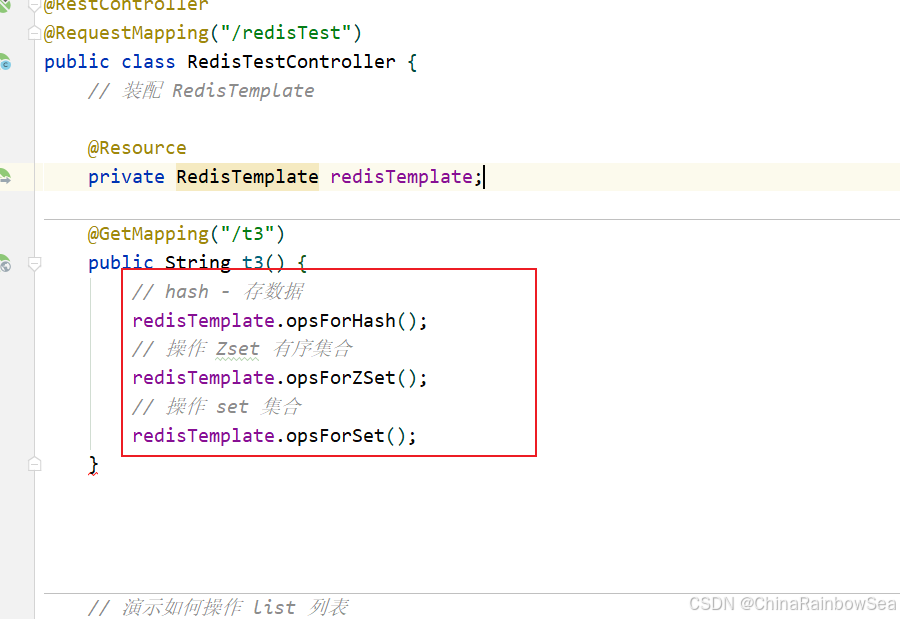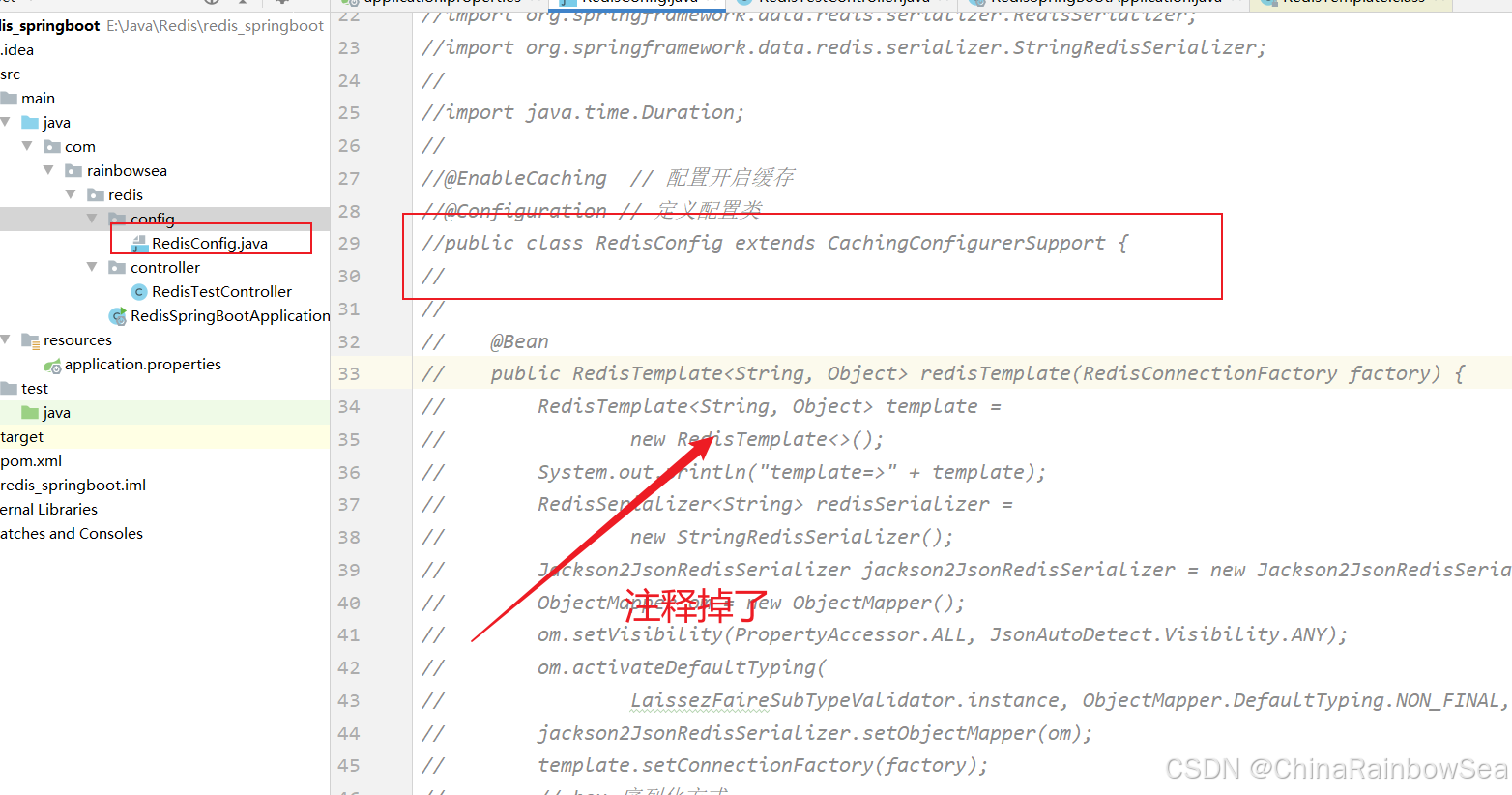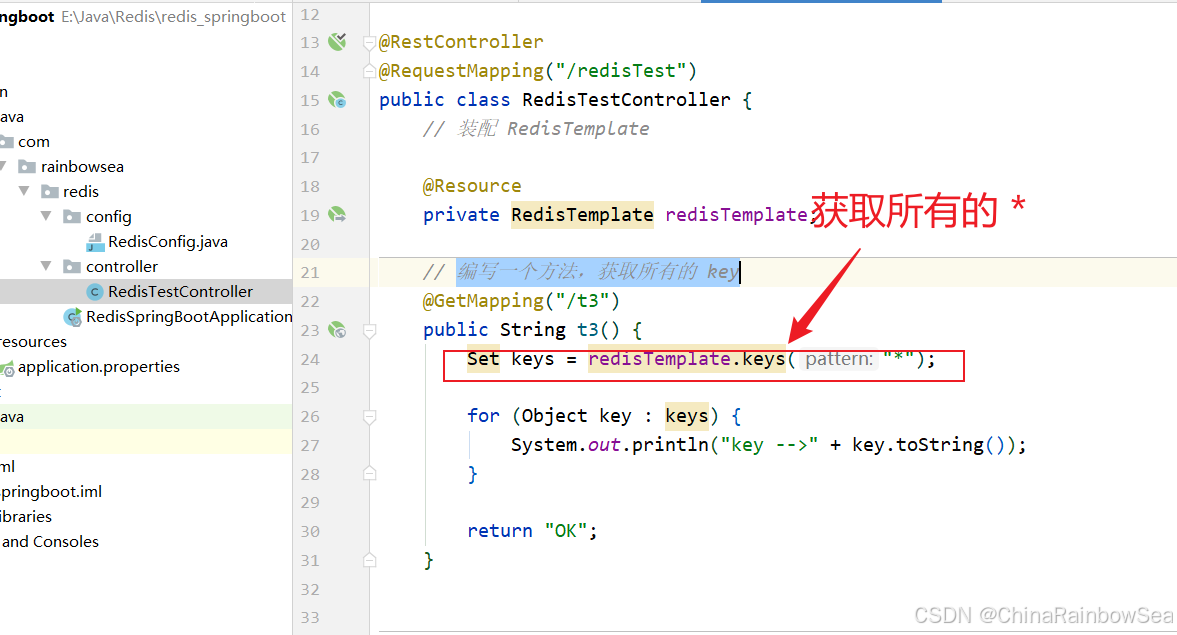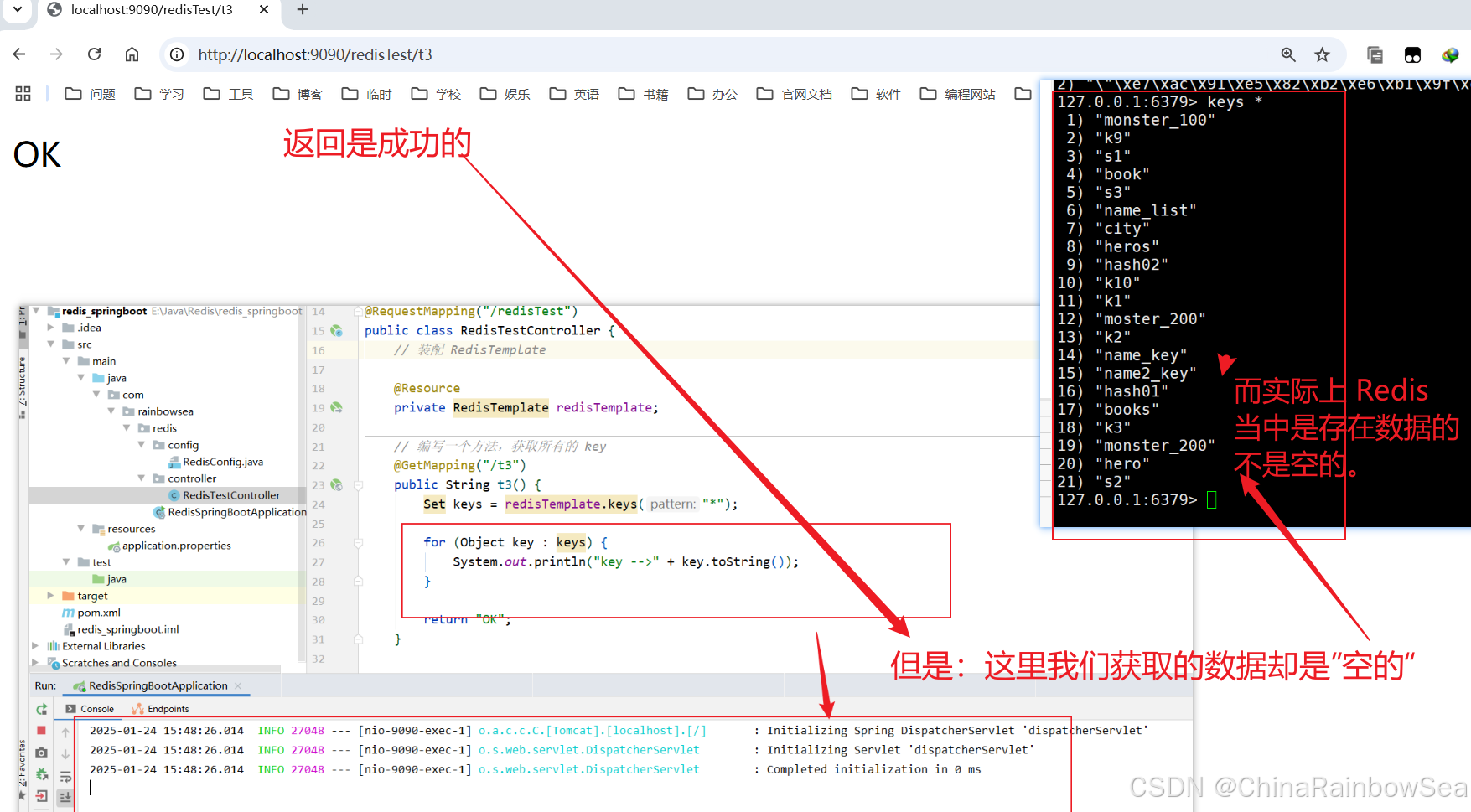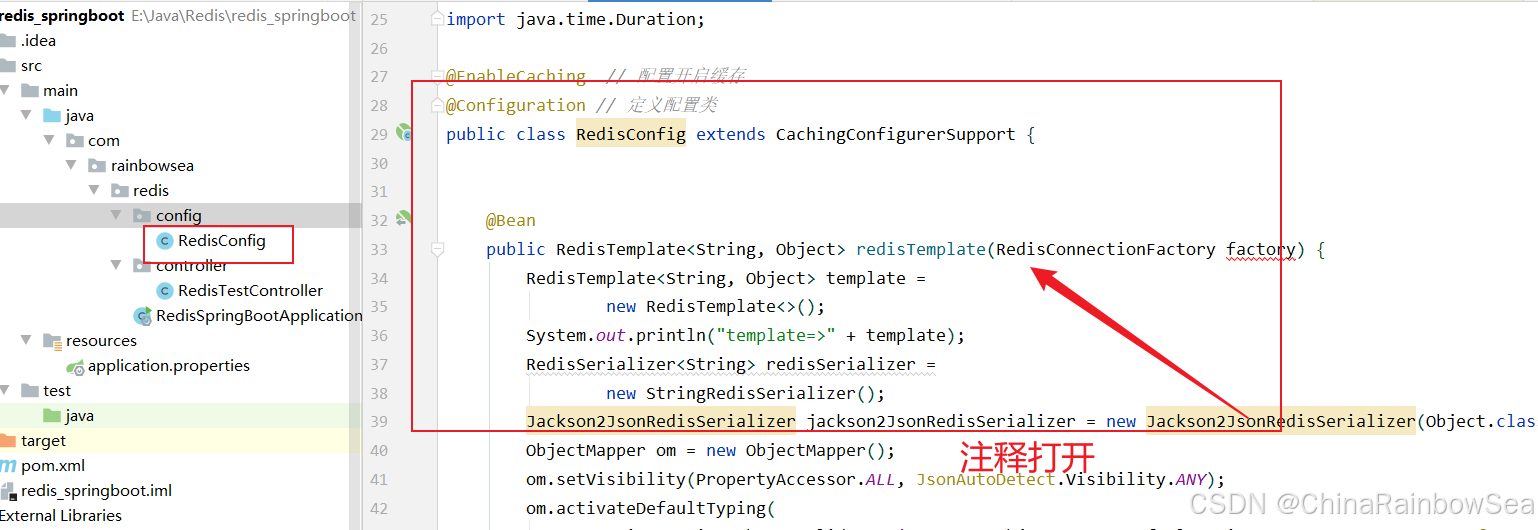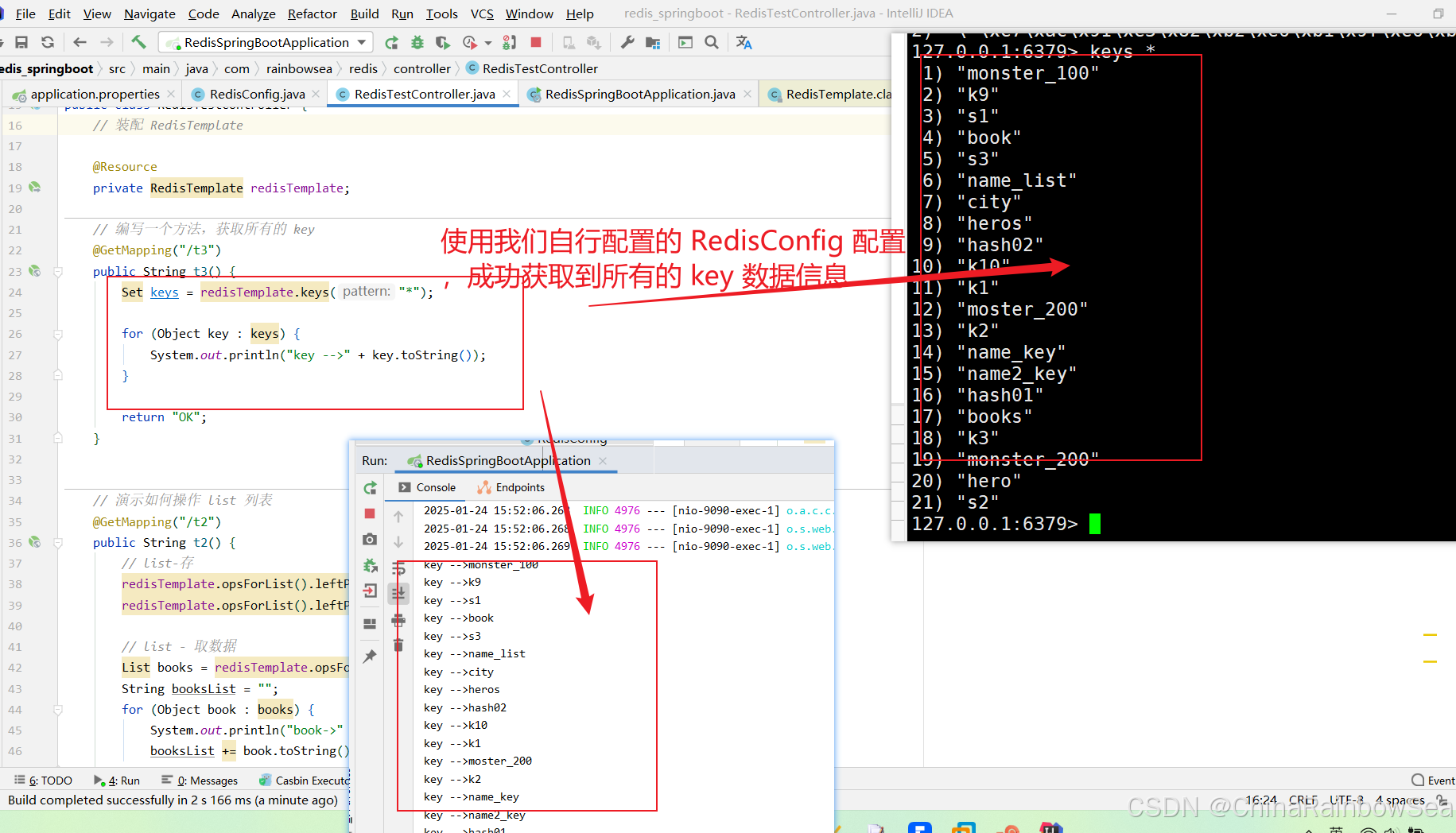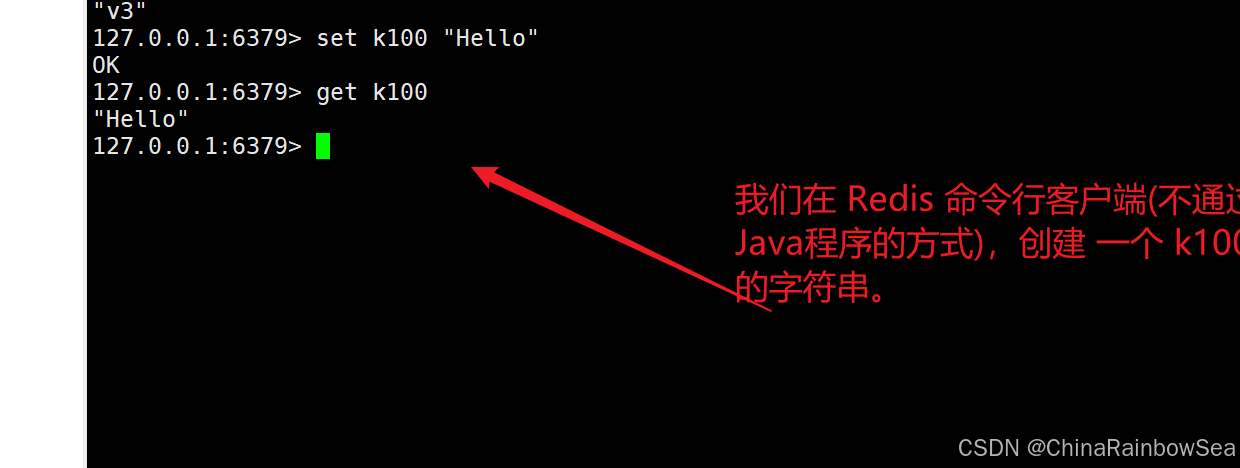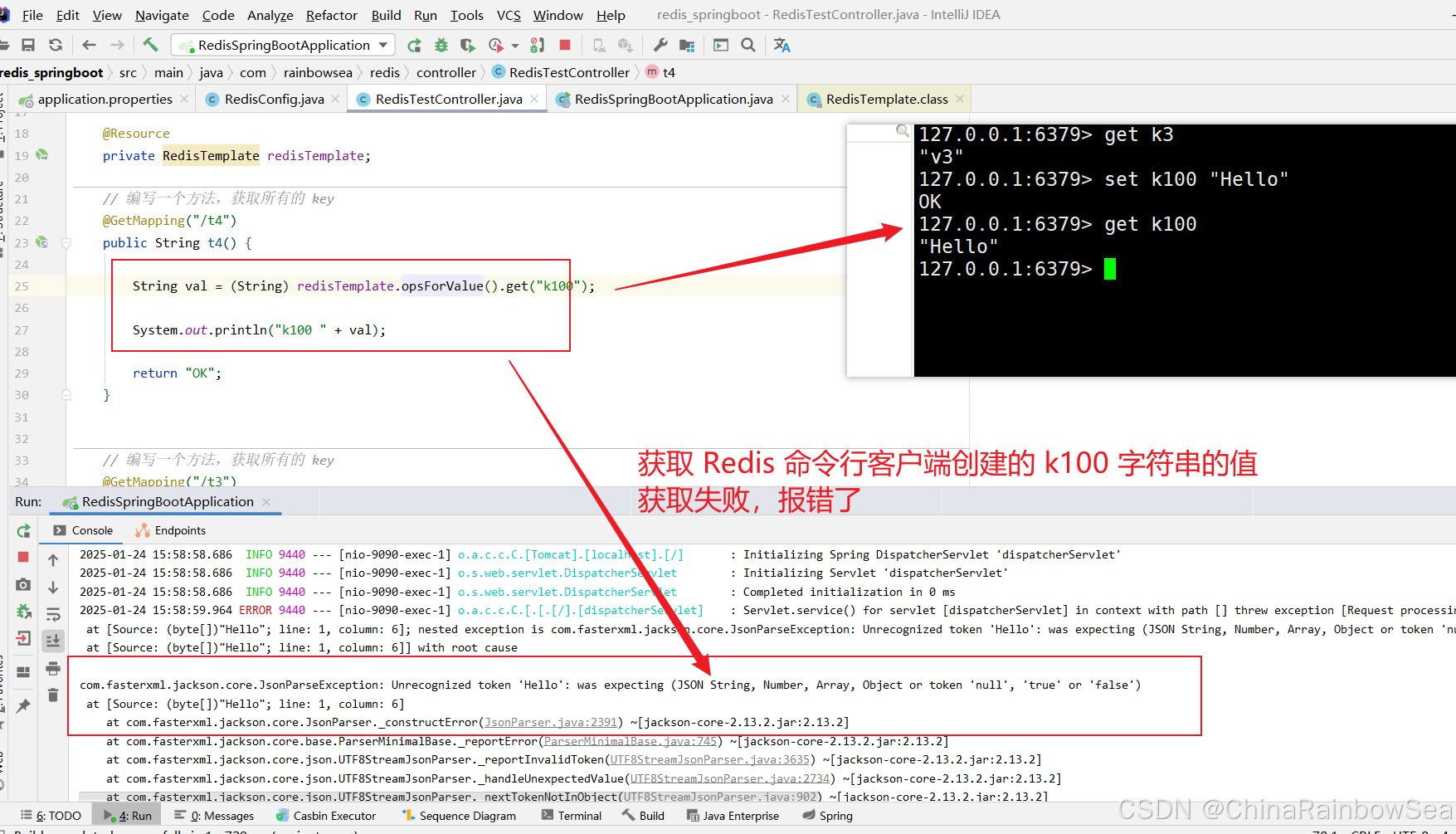八. Spring Boot2 整合连接 Redis(超详细剖析)
在 springboot 中 , 整合 redis
可以通过 RedisTemplate 完成对 redis 的操作, 包括设置数据/获取数据
比如添加和读取数据
具体整合实现:
- 创建 Maven 项目:
- 在 pom.xml 文件当中导入相关的 jar 依赖。如下:
<?xml version="1.0" encoding="UTF-8"?>
<project xmlns="http://maven.apache.org/POM/4.0.0"
xmlns:xsi="http://www.w3.org/2001/XMLSchema-instance"
xsi:schemaLocation="http://maven.apache.org/POM/4.0.0 http://maven.apache.org/xsd/maven-4.0.0.xsd">
<modelVersion>4.0.0</modelVersion>
<parent>
<groupId>org.springframework.boot</groupId>
<artifactId>spring-boot-starter-parent</artifactId>
<version>2.6.6</version>
<relativePath/> <!-- lookup parent from repository -->
</parent>
<groupId>com.rainbowsea</groupId>
<artifactId>redis_springboot</artifactId>
<version>1.0-SNAPSHOT</version>
<properties>
<java.version>1.8</java.version>
</properties>
<dependencies>
<dependency>
<groupId>org.springframework.boot</groupId>
<!-- 说明: 如果这里是 spring-boot-start 就改成如下 spring-boot-start-web-->
<artifactId>spring-boot-starter-web</artifactId>
</dependency>
<!-- redis-->
<dependency>
<groupId>org.springframework.boot</groupId>
<artifactId>spring-boot-starter-data-redis</artifactId>
</dependency>
<!-- spring2.X 集成 redis 所需 common-pool-->
<dependency>
<groupId>org.apache.commons</groupId>
<artifactId>commons-pool2</artifactId>
<!--不要带版本号,防止冲突-->
</dependency>
<dependency>
<groupId>org.springframework.boot</groupId>
<artifactId>spring-boot-starter-test</artifactId>
<scope>test</scope>
</dependency>
<!-- json 转换的 jar 包依赖-->
<dependency>
<groupId>com.fasterxml.jackson.core</groupId>
<artifactId>jackson-databind</artifactId>
<version>2.13.2.2</version>
</dependency>
</dependencies>
<!-- 插件-->
<build>
<plugins>
<plugin>
<groupId>org.springframework.boot</groupId>
<artifactId>spring-boot-maven-plugin</artifactId>
</plugin>
</plugins>
</build>
</project>
- 在 resources 目录下创建 application.properties,完成 redis 的基本配置,如下所示:
#Redis 服务器地址
spring.redis.host=192.168.76.145
#Redis 服务器连接端口
spring.redis.port=6379
#Redis 如果有密码,需要配置, 没有密码就不要写
spring.redis.password=rainbowsea
#Redis 数据库索引(默认为 0)
spring.redis.database=0
#连接超时时间(毫秒)
spring.redis.timeout=1800000
#连接池最大连接数(使用负值表示没有限制)
spring.redis.lettuce.pool.max-active=20
#最大阻塞等待时间(负数表示没限制)
spring.redis.lettuce.pool.max-wait=-1
#连接池中的最大空闲连接
spring.redis.lettuce.pool.max-idle=5
#连接池中的最小空闲连接
spring.redis.lettuce.pool.min-idle=0
- 创建/定义一个 Redis 配置类。
- 这个 Redis 配置类是对要使用 RedisTemplate bean 对象的配置,可以理解成是一个常规配置。
- 和我们以前学过的一个 JdbcTemplate 的设计理念类似。
- 如果不是配置,那么 Spring boot 会使用默认配置,这个默认配置,会出现一些问题,比如:redisTemplate 的 key 序列化等问题,所以通常我们需要配置这个。Redis 配置类.
创建:\redis_springboot\src\main\java\com\rainbowsea\redis\config\ RedisConfig.java 配置类
package com.rainbowsea.redis.config;
import org.springframework.cache.annotation.CachingConfigurerSupport;
import org.springframework.cache.annotation.EnableCaching;
import org.springframework.context.annotation.Configuration;
import com.fasterxml.jackson.annotation.JsonAutoDetect;
import com.fasterxml.jackson.annotation.JsonTypeInfo;
import com.fasterxml.jackson.annotation.PropertyAccessor;
import com.fasterxml.jackson.databind.ObjectMapper;
import com.fasterxml.jackson.databind.jsontype.impl.LaissezFaireSubTypeValidator;
import org.springframework.cache.CacheManager;
import org.springframework.cache.annotation.CachingConfigurerSupport;
import org.springframework.cache.annotation.EnableCaching;
import org.springframework.context.annotation.Bean;
import org.springframework.context.annotation.Configuration;
import org.springframework.data.redis.cache.RedisCacheConfiguration;
import org.springframework.data.redis.cache.RedisCacheManager;
import org.springframework.data.redis.connection.RedisConnectionFactory;
import org.springframework.data.redis.core.RedisTemplate;
import org.springframework.data.redis.serializer.Jackson2JsonRedisSerializer;
import org.springframework.data.redis.serializer.RedisSerializationContext;
import org.springframework.data.redis.serializer.RedisSerializer;
import org.springframework.data.redis.serializer.StringRedisSerializer;
import java.time.Duration;
@EnableCaching // 配置开启缓存
@Configuration // 定义配置类
public class RedisConfig extends CachingConfigurerSupport {
@Bean
public RedisTemplate<String, Object> redisTemplate(RedisConnectionFactory factory) {
RedisTemplate<String, Object> template =
new RedisTemplate<>();
System.out.println("template=>" + template);
RedisSerializer<String> redisSerializer =
new StringRedisSerializer();
Jackson2JsonRedisSerializer jackson2JsonRedisSerializer = new Jackson2JsonRedisSerializer(Object.class);
ObjectMapper om = new ObjectMapper();
om.setVisibility(PropertyAccessor.ALL, JsonAutoDetect.Visibility.ANY);
om.activateDefaultTyping(
LaissezFaireSubTypeValidator.instance, ObjectMapper.DefaultTyping.NON_FINAL, JsonTypeInfo.As.WRAPPER_ARRAY);
jackson2JsonRedisSerializer.setObjectMapper(om);
template.setConnectionFactory(factory);
// key 序列化方式
template.setKeySerializer(redisSerializer);
// value 序列化
template.setValueSerializer(jackson2JsonRedisSerializer);
// value hashmap 序列化
template.setHashValueSerializer(jackson2JsonRedisSerializer);
return template;
}
@Bean
public CacheManager cacheManager(RedisConnectionFactory factory) {
RedisSerializer<String> redisSerializer =
new StringRedisSerializer();
Jackson2JsonRedisSerializer jackson2JsonRedisSerializer = new Jackson2JsonRedisSerializer(Object.class);
//解决查询缓存转换异常的问题
ObjectMapper om = new ObjectMapper();
om.setVisibility(PropertyAccessor.ALL, JsonAutoDetect.Visibility.ANY);
om.activateDefaultTyping(
LaissezFaireSubTypeValidator.instance,
ObjectMapper.DefaultTyping.NON_FINAL,
JsonTypeInfo.As.WRAPPER_ARRAY);
jackson2JsonRedisSerializer.setObjectMapper(om);
// 配置序列化(解决乱码的问题),过期时间 600 秒
RedisCacheConfiguration config = RedisCacheConfiguration.defaultCacheConfig()
.entryTtl(Duration.ofSeconds(600))
.serializeKeysWith(RedisSerializationContext.SerializationPair.fromSerializer(redisSerializer))
.serializeValuesWith(RedisSerializationContext.SerializationPair.fromSerializer(jackson2JsonRedisSerializer))
.disableCachingNullValues();
RedisCacheManager cacheManager = RedisCacheManager.builder(factory)
.cacheDefaults(config)
.build();
return cacheManager;
}
}
- 创建 controller 访问设置/获取到 Redis 数据库当中的数据。
重点: 我们这里的
RedisTemplate模板对象,就是已经配置好了 Jedis 的连接上 Redis的一个模板,该模板提供了很多,我们操作 Redis 数据库的方法。就和我们前面学习 MySQL ,操作连接 MySQL 当中的 JdbcTemplate 模板是类似的。
如下所示:
package com.rainbowsea.redis.controller;
import org.springframework.data.redis.core.RedisTemplate;
import org.springframework.web.bind.annotation.GetMapping;
import org.springframework.web.bind.annotation.RequestMapping;
import org.springframework.web.bind.annotation.RestController;
import javax.annotation.Resource;
@RestController
@RequestMapping("/redisTest")
public class RedisTestController {
// 装配 RedisTemplate
@Resource
private RedisTemplate redisTemplate;
// 编写一个测试方法
// 演示设置数据和获取数据
@GetMapping("/t1")
public String t1() {
// 设置值到 redis 当中,opsForValue 是操作 string 字符串的
redisTemplate.opsForValue().set("book", "天龙八部");
// 从 redis 当中获取值
String book = (String) redisTemplate.opsForValue().get("book");
return book;
}
}
- 创建场景启动器。
package com.rainbowsea.redis;
import org.springframework.boot.SpringApplication;
import org.springframework.boot.autoconfigure.SpringBootApplication;
@SpringBootApplication
public class RedisSpringBootApplication {
public static void main(String[] args) {
SpringApplication.run(RedisSpringBootApplication.class, args);
}
}
- 启动程序run, 打开浏览器地址栏上输入:http://localhost:9090/redisTest/t1 。
在这里插入图片描述
**演示:如何操作 List **
package com.rainbowsea.redis.controller;
import org.springframework.data.redis.core.RedisTemplate;
import org.springframework.web.bind.annotation.GetMapping;
import org.springframework.web.bind.annotation.RequestMapping;
import org.springframework.web.bind.annotation.RestController;
import javax.annotation.Resource;
import java.util.List;
@RestController
@RequestMapping("/redisTest")
public class RedisTestController {
// 装配 RedisTemplate
@Resource
private RedisTemplate redisTemplate;
// 演示如何操作 list 列表
@GetMapping("/t2")
public String t2() {
// list-存
redisTemplate.opsForList().leftPush("books", "笑傲江湖");
redisTemplate.opsForList().leftPush("books", "hello world");
// list - 取数据
List books = redisTemplate.opsForList().range("books", 0, -1);
String booksList = "";
for (Object book : books) {
System.out.println("book->" + book.toString());
booksList += book.toString();
}
return booksList;
}
// 编写一个测试方法
// 演示设置数据和获取数据
@GetMapping("/t1")
public String t1() {
// 设置值到 redis 当中,opsForValue 是操作 string 字符串的
redisTemplate.opsForValue().set("book", "天龙八部");
// 从 redis 当中获取值
String book = (String) redisTemplate.opsForValue().get("book");
return book;
}
}
演示:如何操作 hash
@RestController
@RequestMapping("/redisTest")
public class RedisTestController {
// 装配 RedisTemplate
@Resource
private RedisTemplate redisTemplate;
@GetMapping("/t3")
public String t3() {
// hash - 存数据
redisTemplate.opsForHash();
// 操作 Zset 有序集合
redisTemplate.opsForZSet();
// 操作 set 集合
redisTemplate.opsForSet();
return null;
}
2. 注意事项和细节
- 如果没有提供 RedisConfig 配置类 , springboot 会使用默认配置 也可以使用。但是会存在问题。比如 redisTemplate 模糊查找 key 数据为空。
测试:
这里我们先将 我们配置的 RedisConfig 配置类注释掉。
编写一个方法,获取所有的 key:
*,表示获取所有的 key
@RestController @RequestMapping("/redisTest") public class RedisTestController { // 装配 RedisTemplate @Resource private RedisTemplate redisTemplate; // 编写一个方法,获取所有的 key @GetMapping("/t3") public String t3() { Set keys = redisTemplate.keys("*"); for (Object key : keys) { System.out.println("key -->" + key.toString()); } return "OK"; } }
**当我们将我们的配置的 RedisConfig 类打开,不使用 Spring Boot 默认的配置。则不会出现该空的情况。 **
Unrecognized token 'beijing': was expecting ('true', 'false' or 'null')
看报错,是 jason 转换异常,实际上是因为 redisTemplate 在做数据存储的时候会把存储的内容序列化,所以,redisTemplate 读取的时候也会反序列化,而在 redis 客户端 set 的时候并不会做序列化,因此 set 的进去的值在用 redisTemplate 读的时候就会报类 型转换异常了。
演示:
我们在 Redis 命令行客户端(不通过Java程序的方式),创建 一个 k100的字符串。 然后,我们再通过Java程序获取到该(Redis命令行客户端)所创建的 k100 字符串的数据。
解决这个
com.fasterxml.jackson.core.JsonParseException也简单,既然我们 Resi 命令行客户端(创建的 对象信息/值)不会被序列化,那我们就不用 Redis 命令行客户端创建对象了,直接就是。我们想用Java程序当中反序化的功能:我们就用 Java程序创建对象/值,同时也用Java程序获取对象的数据。存和取都保持一致,都是在Java程序当中即可(因为Java程序创建的对象会自行序列化的)。这里就不演示了,因为我们上述的所有操作都是:Java程序连接 Redis 创建对象,也是Java程序获取数据。都是没问题的。
3. 最后:
“在这个最后的篇章中,我要表达我对每一位读者的感激之情。你们的关注和回复是我创作的动力源泉,我从你们身上吸取了无尽的灵感与勇气。我会将你们的鼓励留在心底,继续在其他的领域奋斗。感谢你们,我们总会在某个时刻再次相遇。”
